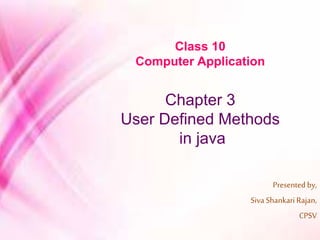
User Defined Methods in Java: Class 10 Computer Application Chapter 3
- 1. Class 10 Computer Application Chapter 3 User Defined Methods in java Presented by, Siva Shankari Rajan, CPSV
- 2. What is method? A method or a function is a sequence of statements grouped together and given a name This group of statements can be called at any point in the program using its name to perform a specific task.
- 3. Why to use methods? Methods are used in the programs for various reason To code complexity To hide the details For reusable code To simplify program maintenance
- 5. Method Declaration It declare either specifies the type of the value which a method will return or use the keyword void to indicate that it will not return any value
- 6. Method Declaration A method consists of two parts: • Header part • Body part. The method header is the first line of the function declaration or definition. The method body contains a set of statements for related operations written in curly brackets.
- 7. Method Declaration Header part : 1. Modifier 2. Return type 3. Method name 4. Parameter list Modifier tells the compiler how to call the method. Return type specifies the type of value returned from a function. Function name is the name assigned to the method. Parameter list is comma- separated list of variables of a function.
- 8. The methods are of two types: 1. Built in method 2. User defined method The built-in methods are pre-defined methods stored in the Java library. The user-defined methods are defined by the programmers as per their need.
- 9. A Method exists in three different forms within a program: Method prototype Method definition Method call
- 10. Method Prototype Method Definition Function prototype is the first line of the method definition ended by semicolon that tells the program about the signatures of the function. A method is called (invokedorexecuted)by providing the method name along with the argument list enclosed in the parenthesis.
- 11. Method Call A method is called (invokedorexecuted)by providing the method name along with the argument list enclosed in the parenthesis.
- 12. Method Signature It is basically refers to the number and types of the arguments in the method. It itself is used to refer to a method prototype. Public class drawing { Public void draw(String s) {….} Public void draw(int i) {….} Public void draw(double d) {….} Public void draw(int I, double s) {….} } Is also called method overloaded
- 13. Arguments An argumentis a value itself that is passed to a method when it is executed Parameters the parameter list appears between the parentheses following the method name. Public void main(){ A=obj.Sum(5,8);//5,8 arearguments being passed toparameter x andy ---------- ---------- } Float Sum(int x, int y){ Float add=(x+y)/2; //x andy areparameter Return add; }
- 14. Actual parameter Theparameter that appear in a method call statement arecalled actual parameter. Formal Parameter the parameter that appear in the function definition are called formal parameter. Public int sum(int a, int b) { return a+b; //a andbareformal parameter } int length=10; int breadth=5; int add=sum(length,breadth); //areactual parameter
- 15. How to access Method? A method can be accessed or called by providing the name of the method followed by parameter enclosed in parentheses. Class callmethod { Public double area(double a, double b) { double x; x=a*b; return x; } Public void accessingmethod() {double x,y,z; x=3.0;y=9.3; z=area(x,y);//calling method area() System.out.println(z);
- 16. Pure functions Thefunction which returnvalues and do not change state are called purefunction. impure function Thefunction which changesthe state of objects is called impure function class add { private double a,b,c; public add() {a=10.0;b=10.0;c=1.0;} public double sum() { return(a+b);// purefunction, return exact value } public void sum1() {c=a+b;//impurefunction, value ofcvaries System.out.println(c);}
- 17. Passing values to method Values can be passed in the following two ways, 1. Call by value 2. Call by address (reference) Call by value Themethod createsits newset of variables to copy the value of actual parameters andworks with them Call by address Reference of the actual parameters is passed on to the method. No newset ofvariables is created.
- 18. Call by value class passbyvalue { public void changed() { int a=12; System.out.println(“original value=“+a); System.out.println(“changed value=“+value(a)); System.out.println(“again value=“+a); } public static int value(int x) { x=10; return x; } }
- 19. Call by Reference class Test { int x; Test(int i) { x = i; } Test() { x = 0; } } class Main { public static void main(String[] args) { Test t = new Test(5); // t is a reference change(t); System.out.println(t.x); } public static void change(Test t) { t = new Test(); t.x = 10; } }
- 20. RecursiveMethod Recursionin java is a process in which a method calls itself continuously. It makes the code compact but complex to understand. public class RecursionExample1 { static void p(){ System.out.println("hello"); p(); } public static void main(String[] args) { p(); } }
- 21. Method overloading Method overloading means that there are more than one function doing different kinds of jobs but have same name. this process is also known as polymorphism. Public class calc { Public void sum(int s,int v) {System.out.println(s+v); } Public void sum(int I, int j,int k) { System.out.println(i+j+k); } Public static void main(string args[]) { calc ob=new calc(); Ob.sum(7,8); Ob.sum(4,5,7);} }